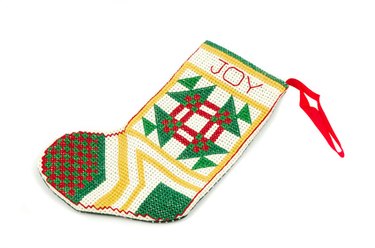Things You'll Need
Completed needlepoint
Stretcher frames
Push pins
Wet cloth
Sewing machine
Heavy-duty sewing thread
Scissors
Straight pins
Fabric for backing and lining (based on size of stocking)
Lightweight cotton batting
Sharp hand sewing needles
Twisted drapery cording for trim (based on size of stocking)

Although needlepoint stockings can be finished in a variety of ways, the most basic method of assembly does not require a professional finisher but can be done by an amateur, with professional-looking results. To increase success, three key decisions must be made after you have stitched the needlepoint but before final assembly. These decisions affect the finishing process. You need to decide on a choice of fabrics for the stocking back and lining, a choice of decorative cording and trim and the desired finished size of the stocking.
Blocking
Step 1
Block the finished needlepoint by mounting it on a stretcher frame with push pins. Start by attaching the blank canvas to the frame at the center of each of the four sides. Do not place push pins in the stitching.
Video of the Day
Step 2
Dampen the canvas by gently pressing the wet cloth to the top section of the needlepoint. Then stretch it as taut as possible from the centers out to each side, placing push pins about 1/4" apart around the canvas.
Step 3
Continue dampening around each side of the stocking and re-stretching until the stocking is straight.
Step 4
Dampen the entire needlepoint one last time and allow it to dry completely (about 24 to 48 hours).
Assembly
Step 1
Remove the blocked needlepoint and machine stitch around the entire stocking, using a 1/4" to 5/8" zigzag setting, as close as possible without touching the needlepoint. This will prevent unraveling as you work with the backing and lining.
Step 2
Carefully cut off the excess canvas close to the outside of the zigzag stitches. Take care not to cut the stitches you've just sewn. Only the stocking-shaped needlepoint should remain.
Step 3
Pin the stocking-shaped needlepoint to the wrong side of the backing fabric and use as a template to cut out one piece. Remove the pins and repeat for the cotton batting.
Step 4
Fold the lining fabric in half with the right side facing inside. Pin the stocking-shaped needlepoint to the lining and cut out two pieces. Remove the pins and set the lining aside.
Step 5
Re-pin the cotton batting to the wrong side of the stocking-shaped needlepoint and baste around the entire piece one canvas thread inside the stitched needlepoint.
Step 6
Place the right sides of the stocking-shaped needlepoint and the fabric backing together and pin the sides and bottom. Stitch around the stocking, making sure to catch the batting, but leave the top open. Make small clips in the curves and turn the stocking right side out.
Step 7
Sew the lining pieces in the same manner, leaving an opening along one side for turning. Make small clips in the curves but do not turn the piece right side out.
Step 8
With right sides together, slide the lining over the stocking from bottom to top, making sure that side seams match. Stitch around the top, and then turn the stocking right side out through the opening in the lining. Hand-stitch the opening closed.
Step 9
Place the lining inside the stocking and make small tacking stitches to anchor the lining to the side seam and bottom seam allowances.
Trimming
Step 1
Undo a few machine stitches in the top right side seam of the stocking. Tuck one end of the drapery cording inside and tack by hand to close.
Step 2
Slip-stitch the cording by hand down the right side of the stocking and up to the top left. Tack in place.
Step 3
Without cutting the cord, continue to stitch around to the right edge. Make a 2 1/2" loop and tack securely to the stocking. Continue to stitch cording around to the left side of the top.
Step 4
Cut off the cording and tuck the end into the inside of the top left seam allowance. Tack securely and stitch the opening closed.
Tip
Medium-weight fabrics like cotton velveteen should be used for the backing, while satin or a lighter-weight cloth works best for the lining.
The use of decorative trim and desired finished stocking size are a matter of personal preference and should complement the needlepoint.
Video of the Day